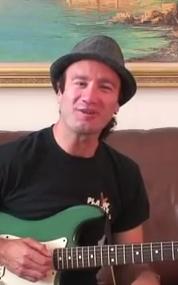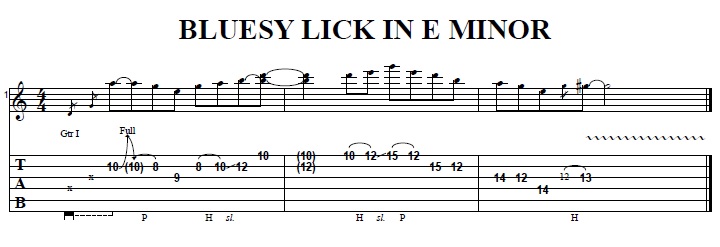CLICK HERE FOR KILLER GUITAR CONTROL SECRETS.
Hey, guys. It’s Claude Johnson here and today’s video
is called “Blues Licks in E”. Now, whether you want
to play the blues or another style like rock or country
or jazz or metal, it all comes from — all the lead
guitar comes from the blues. We’re going to get into
the key of E. it’s a really good key. I’m going to show
you a couple of things and we’ll start out real basic
for you newbies and then hopefully get into some more
advanced stuff, too. Here we go.
Let’s start with the basics and let’s talk about the
pentatonic scale. Now, we can start this basic shape
on any note. For example, the 3rd fret is a G or the
5th fret is the A, but when we’re starting in on the E,
we’re not fretting a note, we’re just going to use the
open string. So we have this.
Basically, that’s the open string, 3rd fret; open string,
2nd fret on the next string; open 2nd; open 2nd and then
the top two strings are open 3. Once again. We’re not
necessarily going to play this as a scale; we’re going
to do licks in a second. But I want you to be aware of
that. And if you’re not familiar with basic pentatonic
scale, check out my lead guitar course for beginners,
which is called “Killer Lead Guitar Made Simple”.
So we have our basic pentatonic scale.
We can start out with like a basic lick like this.
G string, 2nd fret; G string open; and then D string,
2nd fret. And give it a little vibrato; shake it.
Guitar playing is not rocket science, but we’ve got
to add these little things to make it cool, right?
Again, go over vibrato in my courses as well.
So you’ve got that down.
Now let’s take advantage of the fact that we’re
in the key of E and use our open strings. So let’s
add the low E string to that lick. And I want you
to play around with the rhythm. So instead of just
doing a real — playing like… Play around with
different variations, like… Or… You can stay
on this string for a little bit. Or this string.
You can pull-off. But we’re always landing on
that root. Again, you can add the other strings in.
Or the high E string.
Now, I’ve got the camera focused on the left hand
so you can’t see what this hand is doing, but basically
just picking that high open E string there. Don’t worry
about the other hand for you. You can either pick it
or just use your finger to pluck.
That’s another thing you can do, is a trill. You can
just hammer-on and pull-off real quick. There’s another
little move I want to show you. What I’m doing here is
I’ve got my middle finger on the 2nd fret of the D string.
I’m flattening it out to get the 2nd fret of the G string.
So I’m playing the note and then open G string, play the
note again and then fret the G string. That little move
right there was G string open note to the root — we’re
always going back to the root here. We’re going to repeat.
Don’t forget the vibrato.
Here’s a little move that Sol showed me from his
“Blues Master Class” course. So this is not in the
pentatonic scale, but we can go from the 2nd fret to
the 1st fret, on that high E string. So hopefully
you’ve got that down.
Now you can try adding some of the other strings in.
Let me show you that little lick there. That was kind
of cool. Real slow. Cool, right?
Here’s another thing you can do. Remember, when we got
up to here we’re on the 3rd fret and what I’m doing with
this, I’m playing a quarter note bend. Instead of just
this — it doesn’t sound bad, but — give it a lot of
attitude when you bend it like that.
When I say quarter note, what I mean is that —
or quarter step. A whole step is two frets; a half
step is one fret, but I’m not even bending up that high.
For example, if I was going to bend up that high it would
sounds like this. So I’m kind of halfway between this and
this. So… And then high E string. Bend. Same on the high
E string. Quarter note bend; open E; 3rd fret of the B string
— or actually, just open B string. Once again, quarter note
bend on the high E string; open E, open B. Or for the last
note you can hit the 3rd fret. This one is like open B; bend
and then high E string. You can combine these two like this.
Real slow. Open B, 3rd fret of the B string bend; high E;
open B again; high E string, 3rd fret bend and then high E.
Also, when you’re on the 2nd fret here, of the G string,
you can bend that, which is — that’s a full step. You’re
bending up basically to the 4th fret. And for this, I like
to choke down on it so I’m pulling. Normally when we play
lead we’re usually bending up. But this case it’s just
easier to bend — pull it down toward the floor. Same
thing on the B string. You’re pulling down. On the high E,
if you pulled it down you’d pull it off the neck. So that
one you kind of have to go up.
Here’s another thing you can do. When you’re here on the
A string, you can go on the 1st fret here. That’s the
blue note, which I also talked about on my other course,
“Killer Guitar Control Secrets”.
I could probably go on for like another hour with a
gazillion licks, but I think I gave you enough to work
on for today. So try coming up with your own licks and
this is just a great position, this open pentatonic E
thing here.
All right, guys. That’s all I got for you today.
Stay tuned; I’ll have more stuff for you and don’t
forget to subscribe to the YouTube channel and if
you’re not on my mailing list, makes sure you get
on there. Please send this to your guitar friends
and, hey, man, have an awesome day. Catch you next time.



